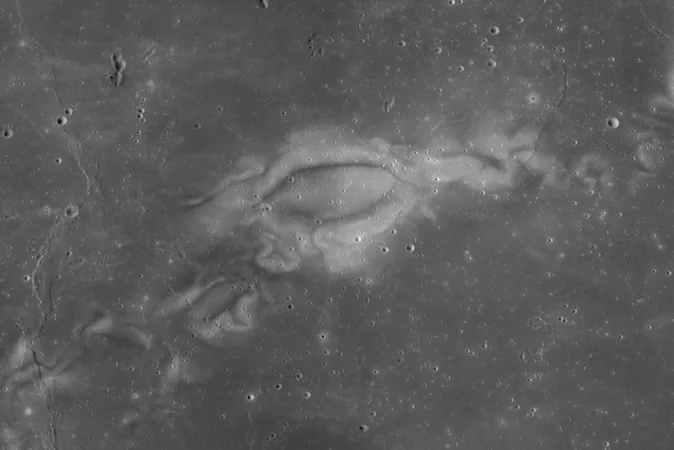
Shocking Discoveries Reveal the Moon's Hidden Magnetic Field!
2025-01-03
Author: Li
Shocking Discoveries Reveal the Moon's Hidden Magnetic Field!
Recent findings from China’s revolutionary Chang’e 5 mission have upended our understanding of the Moon’s history, suggesting that it boasted a magnetic field well into its midlife—much longer than previously thought. Published on January 1 in Science Advances, this research highlights rocks collected from the lunar surface that are only about 2 billion years old yet exhibit weak magnetization.
While these findings are not definitive, they significantly bolster the growing evidence of the lunar surface's dynamism in its early years. Researchers have made a compelling case, using recent samples alongside previous data from past missions, to indicate that not only did the Moon's younger years feature a magnetic field, but it also must have coincided with a molten lunar interior capable of generating such a field over much of its lifetime.
Led by the esteemed Shuhui Cai of the Chinese Academy of Sciences in Beijing, this groundbreaking research continues to add to the wealth of knowledge produced by the successful Chang’e 5 mission, which brought back 3.82 pounds of lunar rocks and soil—the first lunar samples returned to Earth in over four decades. This substantial collection has opened doors to new insights into the Moon's geological past, including surprising evidence of volcanic activity just 125 million years ago, challenging long-held beliefs about its volcanic inactivity over the last billion years.
The Mystery of the Moon's Magnetic Field
The question of whether the Moon once possessed a magnetic field has puzzled scientists for decades. Analysis of samples collected from the Apollo and Russian Luna missions revealed that more than 4 billion years ago, the Moon had a weak global magnetic field, approximately 1/20th of Earth's current magnetic strength. However, robotic and manned explorations have confirmed that the Moon today lacks any such field.
Planetary magnetic fields stem from the "dynamo effect," which generates a magnetic field via the rotation of a molten, electrically conductive fluid, typically iron. This process also hinges on a source of heat to encourage convection within the molten material—a phenomenon that continues to sustain Earth's robust magnetic field.
In its early stages, the Moon was formed from debris resulting from a colossal collision between a Mars-sized body and the proto-Earth. Prior to becoming tidally locked in its rotation, keeping one side perpetually facing Earth, the Moon spun significantly faster, subject to tidal forces that likely maintained considerable internal heat, promoting conditions ripe for the dynamo effect and resulting in a lunar magnetic field.
Today, localized magnetic fields exist on the Moon, some measuring hundreds of nanoteslas, particularly in regions like the Reiner Gamma. These small pockets of magnetism hint at the remnants of a once-strong global magnetic field, but there is ambiguity surrounding the timeline for its disappearance.
The samples returned by Chang’e 5 provided a unique opportunity for adding fresh data to what was previously known from Apollo and Luna missions. Analyzing these samples came with its challenges, particularly the risk of inducing magnetism during collection, transportation, and storage, which researchers had to meticulously account for.
The analysis of the basalt samples from Chang’e 5 conducted by Cai and his team unveiled that the Moon had a magnetic field strength ranging from 2,000 to 4,000 nanoteslas around the time it was 2 billion years old, indicating that conditions suitable for sustaining the dynamo effect were still active. This suggests the Moon's interior remained molten and capable of experiencing convective forces, which would lead to volcanic activity.
Implications for Future Lunar Exploration
The absence of a magnetic field on the Moon has major implications for the presence of water on its surface—critical information for future expeditions aiming to harness lunar resources.
Without a protective magnetic field, solar wind particles hit the Moon's surface freely. The Moon momentarily escapes this bombardment each lunar month when it briefly traverses the trailing tail of Earth’s magnetic field; however, this coverage is insufficient for offering lasting protection.
Solar wind particles, particularly hydrogen and helium atoms, interact with the Moon’s surface materials to create hydroxyls (one hydrogen atom and one oxygen atom) and water molecules (two hydrogen atoms and one oxygen atom), in addition to potentially valuable Helium-3, which may one day be used for rocket fuel. This quest for water is one of the driving forces behind the ongoing Artemis lunar program.
But what if the Moon once had a magnetic field that shielded it from the solar wind? A previous lunar magnetic field could have limited the interaction between solar hydrogen and lunar oxygen, thus reducing the volume of native water trapped in permanently shadowed polar regions. Moreover, reserves of Helium-3 might not be as plentiful as hoped, provoking further questions about the Moon's geophysical evolution and future exploration endeavors.
As scientists digest these findings, excitement builds over what other secrets the Moon may still hold, urging a new wave of exploration that seeks to uncover the hidden chapters of our neighboring celestial body!
 Brasil (PT)
Brasil (PT)
 Canada (EN)
Canada (EN)
 Chile (ES)
Chile (ES)
 Česko (CS)
Česko (CS)
 대한민국 (KO)
대한민국 (KO)
 España (ES)
España (ES)
 France (FR)
France (FR)
 Hong Kong (EN)
Hong Kong (EN)
 Italia (IT)
Italia (IT)
 日本 (JA)
日本 (JA)
 Magyarország (HU)
Magyarország (HU)
 Norge (NO)
Norge (NO)
 Polska (PL)
Polska (PL)
 Schweiz (DE)
Schweiz (DE)
 Singapore (EN)
Singapore (EN)
 Sverige (SV)
Sverige (SV)
 Suomi (FI)
Suomi (FI)
 Türkiye (TR)
Türkiye (TR)
 الإمارات العربية المتحدة (AR)
الإمارات العربية المتحدة (AR)